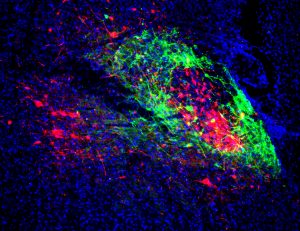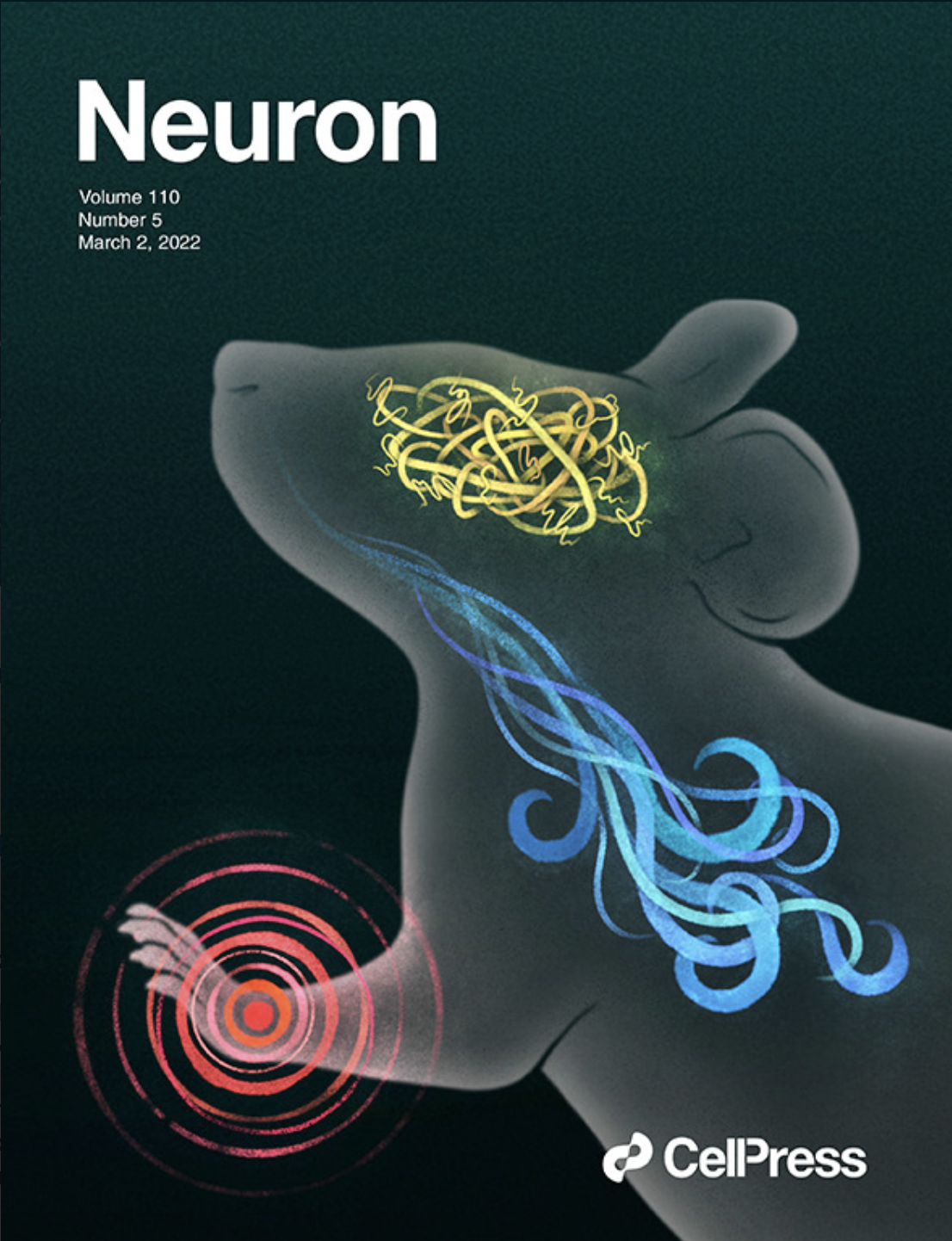
December 17, 2021
Salk scientists discover that a neural circuit coordinates breathing with negative emotions
Salk scientists discover that a neural circuit coordinates breathing with negative emotions
LA JOLLA—You’re startled by a threatening sound, and your breath quickens; you smash your elbow and pant in pain. Why a person’s breathing rate increases dramatically when they’re hurting or anxious was not previously understood. Now, a team of Salk scientists has uncovered a neural network in the brain that coordinates breathing rhythm with feelings of pain and fear. Along with contributions to the fields of pain management, psychological theories of anxiety, and philosophical investigations into the nature of pain, their findings could lead to development of an analgesic that would prevent opioid-induced respiratory depression (OIRD), the disrupted breathing that causes overdose deaths.

In the study published on December 17, 2021, in Neuron, the Salk group focused on a group of neurons in the brainstem called the lateral parabrachial nucleus, which is arranged in a core-shell configuration. They found that neurons in the core project to the amygdala, an area of the brain that processes fear and the emotional experience of pain. Neurons in the shell project to the pre-Bötzinger complex, a region that generates breathing rhythm. The core and shell neurons influence each other according to inputs from these areas, making us breathe faster when we experience pain or anxiety.
“We are the first group to demonstrate how the lateral parabrachial nucleus coordinates breathing and pain,” says the paper’s senior author, Sung Han, assistant professor in Salk’s Clayton Foundation Laboratories for Peptide Biology. “By understanding the circuits in this brain region, we may be able to tease apart breathing regulation and pain regulation to develop a medication that inhibits feelings of pain without repressing breathing, like OIRD.”
In OIRD, opioids repress breathing as well as pain; it is the major cause of death from opioids. In previous work, Han’s lab showed that opiates like morphine repress breathing by triggering specific receptors, called mu opioid receptors (MOR), leading to the inhibition of neurons that express them. They also showed that reactivating the cells that express MOR can reverse OIRD. The current work suggests additional approaches for preventing OIRD, possibly by inhibiting neurons in the region’s core (blunting fear/anxiety) while exciting similar neurons in the shell (supporting breathing).
To show how these neurons coordinate breathing with pain and emotions, the researchers first used light and chemical agents to prove that manipulating the MOR-expressing neurons in the lateral parabrachial nucleus alters breathing rate in mice. They then used fluorescent tracers to map the inputs and outputs to the MOR-expressing neurons. Their results indicated that neurons clustered in the core of the region project to the central amygdala, while neurons clustered in the surrounding shell project to the pre-Bötzinger complex. Electrophysiological recordings of one population while stimulating the other population revealed that some of those subpopulations are reciprocally connected, with an excitatory network between them. Via this network, signals of fear and pain were coordinated with breathing rhythms.

“We have found very intricate circuits involving upstream and downstream input to these neurons. By uncovering this circuit mechanism, we can better explain why breathing can often be coordinated with pain and anxiety,” says first author Shijia Liu, a graduate student in Han’s lab.
Han is eager to see the team’s discovery have a translational application. “The biggest problem these days is that opioids reduce pain but also reduce breathing, so people die,” says Han, holder of the Pioneer Fund Development Chair. “By understanding those two mechanisms in our research, maybe we can manipulate certain populations of neurons by pharmacological intervention so that we can control pain without changing the breathing.”
Han’s group is currently working on genetic analyses of the core and shell population to identify functional markers that specifically regulate pain or breathing.
Other authors on the study are Mao Ye, Gerald M. Pao, Jinho Jhang, Jonghyun Kim, Sukjae Joshua Kang, Dong-Il Kim of Salk; and Samuel Myeongsup Song and Haibei Jiang of the University of California San Diego.
The research was supported by the National Institute of Mental Health, the Brain Research Foundation, the Mary K. Chapman Foundation, the Jesse & Caryl Philips Foundation, the National Institutes of Health-National Cancer Institute and the Waitt Foundation.
DOI: https://doi.org/10.1016/j.neuron.2021.11.029
JOURNAL
Neuron
AUTHORS
Shijia Liu, Mao Ye, Gerald M. Pao, Samuel Myeongsup Song, Jinho Jhang, Haibei Jiang, Jonghyun Kim, Sukjae Joshua Kang, Dong-Il Kim and Sung Han.
JOURNAL COVER

On the cover: Breathing can be heavily influenced by pain or internal emotional states. In this issue of Neuron, Liu et al. (pages 841–856) reveal divergent parabrachial opioidergic pathways that coordinate breathing with pain and anxiety. Breathing is represented by the blue traces flowing along the airway, pain is represented by the red circles centered on the paw, and emotion is represented by the yellow entangled thoughts in the brain. Collectively, this artwork depicts the dynamic coordination of breathing with pain and emotion in mice. Artwork by Amy Cao.
Office of Communications
Tel: (858) 453-4100
press@salk.edu
Unlocking the secrets of life itself is the driving force behind the Salk Institute. Our team of world-class, award-winning scientists pushes the boundaries of knowledge in areas such as neuroscience, cancer research, aging, immunobiology, plant biology, computational biology and more. Founded by Jonas Salk, developer of the first safe and effective polio vaccine, the Institute is an independent, nonprofit research organization and architectural landmark: small by choice, intimate by nature, and fearless in the face of any challenge.
Notifications